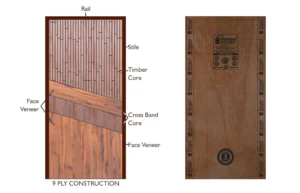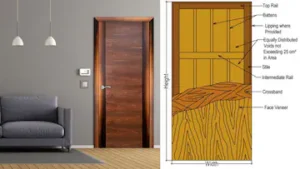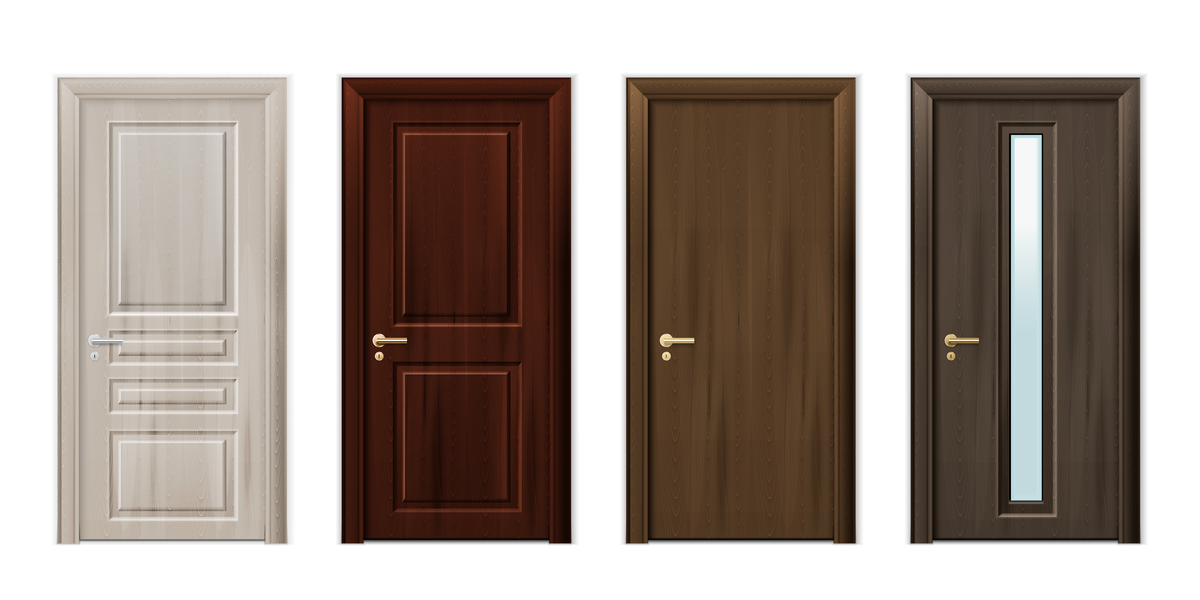Solid Core vs Hollow Core Flush Doors: What’s the Difference? When it comes to selecting interior doors, architects, homeowners, and designers mostly find themselves confused between solid core vs hollow core flush doors. ThereWhile both styles may look similar from the outside, internal composition makes a difference in durability, performance, and cost. Whether you are a contractor building a new building or a homeowner planning to renovate your house, understanding the difference between solid core and hollow core flush doors is important for making a lasting decision.
We will provide all the required information for Solid Core vs Hollow Core Flush Doors: What’s the Difference?, which will be helpful for you to determine which option is best suited to your requirements, space, and budget, which is one of the imperative things to keep in mind.
What is a Solid Core Flush Door?

Solid core flush doors are dense and have a solid interior that is made from wood materials like medium-density fiberboard (MDF), particleboard, or solid wood strips. To provide a smooth surface, this is covered with an outer layer like a laminate, veneer, or plywood. These doors are used in bedrooms, bathrooms, offices, and other areas where strength and soundproofing are pivotal. There are numerous solid core flush door manufacturer but the best flush door manufacturer uses quality material to make solid core flush doors.
Advantages of Solid Core Doors
Excellent Sound Insulation: The dense core lessens sound transmission, which makes these doors ideal for offices, bedrooms, and shared living spaces.
Improves Privacy: Solid doors block noise and light, which is really effective and contributes to great privacy between solid core door rooms.
Premium Feel: If the person wants a solid and weighty feel, then there is nothing other door like solid doors. They provide quicker closing action.
Long-Lasting: The solid core flush doors are strong and less prone to bending or warping with the passage of time.
Versatile Finishing Options: There are several options available, like as veneer types, paint finishes, and laminates.
Fire Resistance: There are various solid doors that provide fire-rated options owing to their density of the material that is used.
Disadvantages of Solid Core Doors
Heavier Doors: These doors are heavier, which makes them more difficult to transport as well as install.
Difficult to Modify: Solid core doors are really difficult to resize and trim without professionals, which increases expenses as well.
Higher Cost: These doors are considered more expensive because of their soundproofing and other advantages.
What are Hollow Core Flush Doors?

If you want lightweight flush doors, then hollow core flush doors are best. They are constructed with a wooden or composite frame. The interior core of this door is made of plastic, honeycomb cardboard, or similar lightweight filler. To cover this internal structure, there a thin outer panels of MDF, plywood, and high-density fibreboard(HDF). These outer panels provide a smooth and flat surface to the hollow core flush doors.
Advantages of Hollow Core Flush Doors
Lightweight: These doors are more lightweight than other flush doors. They are easy to transport and install.
Cost-Effective: If you are looking for a cost-effective option, then this flush door is the best. It is an ideal choice for large projects or budget-conscious builds.
Low Maintenance: The material of hollow core flush doors is generally resistant to warping, cracking, or termite damage under typical indoor conditions.
Readily Available: The hollow doors are widely manufactured in standard sizes as well as finishes, which makes it easy to replace these doors.
Ideal for Low Use Areas: These doors are good for places that need less durability and soundproofing.
Disadvantages of Hollow Core Flush Doors
Less Durable: These doors do not last a long time because they are more susceptible to holes and surface damage from everyday use.
Lower Sound and Thermal Insulation: Another thing is that hollow core flush doors provide minimal noise reduction and less energy efficiency.
Less Secure and Fire-Resistant: These doors are thin and, even with less force to open, can break. The material of hollow core flush doors does not provide fire protection.
Inexpensive Look: Even though it is being finished with laminates or veneers, it looks cheaper.
Explore Solid Core vs Hollow Core Flush Doors: What’s the Difference?
We will provide you with the table that defines the difference between Solid Core and Hollow Core Flush Doors for easy understanding:
| Feature | Solid Core Door | Hollow Core Door |
| Weight | Heavy | Light |
| Durability | High | Low to Moderate |
| Sound Insulation | Excellent | Poor |
| Cost | Higher | Budget-friendly |
| Installation | Difficult, needs a strong frame | Easy to install |
| Best Use | Bedrooms, offices, bathrooms | Closets, low-traffic rooms |
| Fire Resistance | Better | Poor |
| Appearance | Premium look and feel | Basic finish |
Wrapping Up!
It is really hard to choose between a solid core and a hollow core flush door. A solid core flush door has its own pros and cons, like a hollow core flush door. There are numerous factors, like budget, material, durability, and performance, that you are going to prioritize while choosing one. We properly define all the important points with an explanation. Hope this “Solid Core vs Hollow Core Flush Doors: What’s the Difference?” blog will be beneficial for you.







